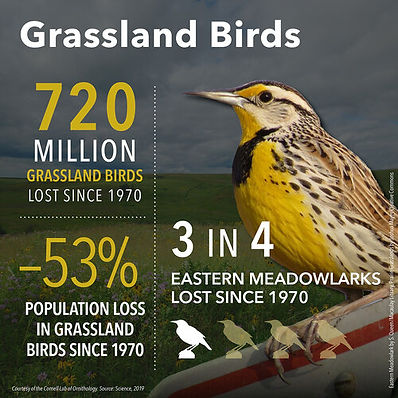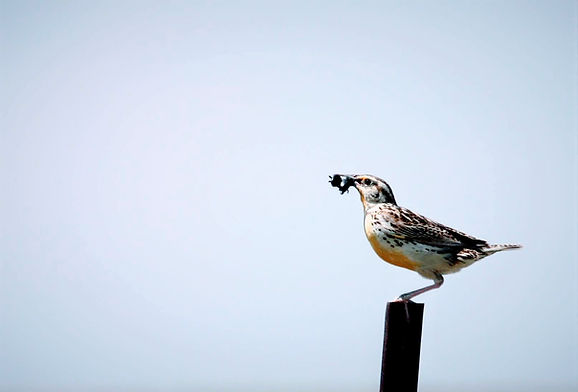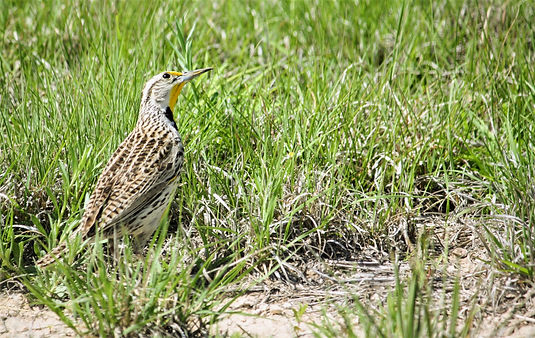.png)
Eastern Meadowlarks are an iconic bird song in southeastern U.S. grasslands. Their ethereal, flutelike song can be heard early in the morning and late in the day in Texas prairies and meadows.
Unfortunately, Meadowlarks, and other grassland birds, are suffering steep declines. We've lost 3 in 4 Eastern Meadowlarks since 1970.
According to the 2025 State of the Birds Report, one-third of U.S. birds are in need of conservation action. Their habitats—along the coast, in forests, and especially grasslands—are vanishing.
As woody-plant and invasive grasses invade prairies, and drought and rapid conversion and development of grasslands shrink available habitat, our grassland birds are suffering steeper declines than any other bird group.
Eastern Meadowlarks are one such grassland bird, considered a "Common Bird Species in Steep Decline".
While habitat management for Meadowlarks will often be site and situationally specific, in general, the following management actions are a few important ways Texans can help...

Take action for grassland birds


1. Restore and manage native prairie grasses and forbs.
Losses of Meadowlarks, and other grassland birds, are primarily due to disappearing grassland habitat. Grassland birds rely on native bunch grasses and forbs for nesting (e.g. the Eastern Meadowlark nests on the ground in grasslands), foraging (i.e. access to seeds and insects that are eaten), and protection from predators.
The Cornell Lab of Ornithology notes, "Prairie is scarce in the eastern United States, and the kinds of farms that once hosted meadowlarks—small, family farms with pastureland and grassy fields—are disappearing."
Private lands conservation efforts in Texas to restore large tracts of grassland habitats, protect existing prairies and grasslands, and promote sustainable land management practices are essential to help reverse the decline of grassland birds such as the Eastern Meadowlark.
As a private landowner, you can help grassland birds by preserving large blocks of grasslands, and restoring and managing for native grasses and forbs. Programs such as Texas Parks and Wildlife's Pastures for Upland Birds can help private landowners restore native grass and forb vegetation on pastures and hayfields dominated by exotic grasses such as bermudagrass, bahiagrass, and Old World bluestems.
Target native grasses to restore include species such as the Big Four Prairie Grasses seen below...

The "Big Four" prairie grasses refer to the four dominant grass species that are key components of the North American tallgrass prairie ecosystem. These four grasses are (1) big bluestem, (2) little bluestem, (3) Indiangrass, and (4) switchgrass.
2. Brush control
Across North America, grassland habitats are encroaching with shrubs and trees, especially due to fire suppression. An overgrowth of shrubs and trees crowd out native grasses and forbs depriving them of light. Increased woody vegetation also allows more habitat for predators that can prey on grassland birds and their chicks.
Eastern Meadowlarks need open, relatively treeless landscapes to thrive. The loss of native grasses and the spread of woody plants diminish the quality of their habitat.
Private landowners can control brush on their property through means such as hand clearing, mulching, targeted herbicide, and ultimately, prescribed fire. Contact your local TPWD wildlife biologist for technical guidance and specifics in getting starting with a brush control program on your property.
3. Avoid mowing/haying during peak nesting season.
Meadowlarks, like many other ground-nesting birds, are highly vulnerable to disturbances during their nesting season. By avoiding mowing during the peak nesting season, this allows grassland birds to complete their nesting cycle—from laying eggs to fledging young. If you must engage in mowing/haying, here are a few best practices:
Delay mowing or haying. If you must mow/hay, the best time is before March and after nesting season has completed in August. Avoid mowing at night. This will help reduce disturbance to ground nesters.
Other ways to help:
-
Adjusting cutters to 8-12 inches (and no less than 6 inches) can not only help native grasses and vegetation recover and survive, but potentially help avoid active ground nests, too.
-
Rotational mowing: Leave some cover undisturbed and areas unmowed each year, and only mow/manage a portion of a field in a given season/year. This ensures there are always some areas with tall grass where grassland birds can nest, forage, and hide from predators.
-
Monitor for nest presence: If delaying mowing/haying isn't feasible, conduct a nest survey before mowing to ensure there are no active nests in the area. Be mindful of any signs of nests, such as birds flying up from the grass/ground or visible eggs and chicks. If nests or grassland bird activity is found, avoid mowing that area until the young have fledged.

Meadowlark carrying beetles for chicks.
©Rachel Rommel
4. Rotational Grazing
While controlled grazing can maintain grassland habitats, incompatible grazing can reduce the quality of habitat available to grassland birds by reducing the vegetation that these birds rely on for nest sites, cover, and food.
Grazing in rotations means that livestock are moved between different pastures or areas of land, allowing grazed areas to recover. This helps to maintain a healthy, diverse plant community, encourages native plant growth, and improves soil health.
By adopting rotational grazing practices, you can manage grasslands in a way that supports both livestock and wildlife, including species like the Meadowlark.
To learn more about developing a rotational grazing plan in Texas, reach out to your local Texas A&M AgriLife Extension Service office or the Natural Resources Conservation Service (NRCS) for expert guidance and resources.

©Rachel Rommel
Landowner resources:
- Oaks and Prairies Joint Venture guidance and assistance for Eastern Meadowlarks - HERE.
- For specific habitat guidance related to your property contact your TPWD wildlife biologist by county - HERE.
- TPWD Pastures for Upland Birds program for grassland restoration program - HERE.
- Learn more about GRIP, the Grassland Restoration Incentive Program - HERE.
- Learn more about the Audubon's Conservation Ranching program - HERE.

